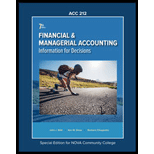
Profit Margin Ratio:
Profit margin ratio represents the profitability of the given product. The formula to calculate profit margin ratio is,
Debt Ratio:
Debt ratio represents the capability of the company to pay its liabilities utilizing its assets. The formula to calculate debt ratio is,
Gross Margin Ratio:
Gross margin ratio measures the degree of profit earned by company by selling its inventory. The formula to calculate gross margin ratio is,
Acid Test Ratio:
Acid test ratio represents the capability of the company to pay its current liabilities by utilizing its quick assets, that is assets which be turned into cash within 90 days. The formula to calculate quick acid ratio is,
The formula to calculate quick assets is,
Accounts Receivable Turnover:
Accounts receivable turnover measures how frequently company recovers its receivables. The formula to calculate accounts receivable turnover is,
Basic Earnings per Share:
Basic earnings per share are a share of profit allocated to every outstanding share of stock. The formula to calculate basic earnings per share is,
Inventory Turnover Ratio:
Inventory turnover ratio is a tool to evaluate the number of times a company sells and change its inventory and how effectively company satisfies its orders. The formula to calculate inventory turnover is,
Dividend Yield:
Dividend yield is the dividend paid on share in comparison to its price. The formula to calculate dividend yield is,
To identify: Change in ratio to be classified under favorable and unfavorable.
Want to see the full answer?
Check out a sample textbook solution
Chapter 13 Solutions
FIN & MANAGERIAL ACCT VOL 2 W/CONNECT
- Please provide the accurate answer to this general accounting problem using valid techniques.arrow_forwardWhich of the following is a real account?a) Capital Accountb) Salaries Expense Accountc) Sales Revenue AccountNeed helparrow_forwardWhich of the following is a real account?a) Capital Accountb) Salaries Expense Accountc) Sales Revenue Accountd) Discount Allowedarrow_forward
- At the beginning of the recent period there were 850 units of product in a department, one-fourth completed. These units were finished and an additional 4,750 units were started and completed during the period. 720 units were still in process at the end of the period, one-fifth completed. Using the weighted-average valuation method, the equivalent units produced by the department were ____ units.arrow_forwardWhat is the main purpose of a cash flow statement?a) To report profits and lossesb) To show changes in equityc) To report cash inflows and outflowsd) To show the company's assetsneed helparrow_forwardWhat was the variable cost of goods soldarrow_forward
- Eagles Manufacturing uses the declining balance method of depreciation. They purchased a machine for $160,000 with an estimated salvage value of $20,000 and a useful life of 5 years. Using a declining balance rate of 30%, calculate the depreciation expense for the second year of the machine's use.arrow_forwardWhat is the correct answer with accounting questionarrow_forwardCan you explain the correct methodology to solve this general accounting problem?arrow_forward
- I want Solutionarrow_forwardWhat is the main purpose of a cash flow statement?a) To report profits and lossesb) To show changes in equityc) To report cash inflows and outflowsd) To show the company's assetsarrow_forwardI need help with this general accounting question using the proper accounting approach.arrow_forward

 AccountingAccountingISBN:9781337272094Author:WARREN, Carl S., Reeve, James M., Duchac, Jonathan E.Publisher:Cengage Learning,
AccountingAccountingISBN:9781337272094Author:WARREN, Carl S., Reeve, James M., Duchac, Jonathan E.Publisher:Cengage Learning, Accounting Information SystemsAccountingISBN:9781337619202Author:Hall, James A.Publisher:Cengage Learning,
Accounting Information SystemsAccountingISBN:9781337619202Author:Hall, James A.Publisher:Cengage Learning, Horngren's Cost Accounting: A Managerial Emphasis...AccountingISBN:9780134475585Author:Srikant M. Datar, Madhav V. RajanPublisher:PEARSON
Horngren's Cost Accounting: A Managerial Emphasis...AccountingISBN:9780134475585Author:Srikant M. Datar, Madhav V. RajanPublisher:PEARSON Intermediate AccountingAccountingISBN:9781259722660Author:J. David Spiceland, Mark W. Nelson, Wayne M ThomasPublisher:McGraw-Hill Education
Intermediate AccountingAccountingISBN:9781259722660Author:J. David Spiceland, Mark W. Nelson, Wayne M ThomasPublisher:McGraw-Hill Education Financial and Managerial AccountingAccountingISBN:9781259726705Author:John J Wild, Ken W. Shaw, Barbara Chiappetta Fundamental Accounting PrinciplesPublisher:McGraw-Hill Education
Financial and Managerial AccountingAccountingISBN:9781259726705Author:John J Wild, Ken W. Shaw, Barbara Chiappetta Fundamental Accounting PrinciplesPublisher:McGraw-Hill Education





